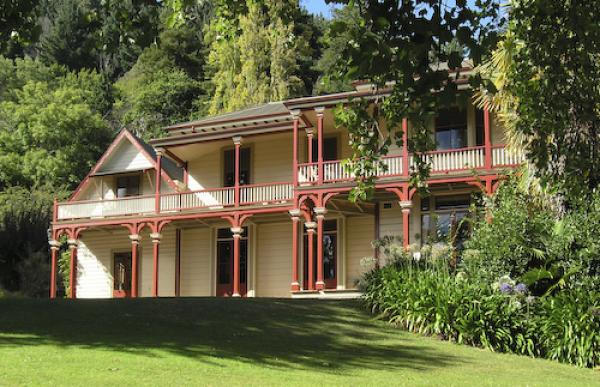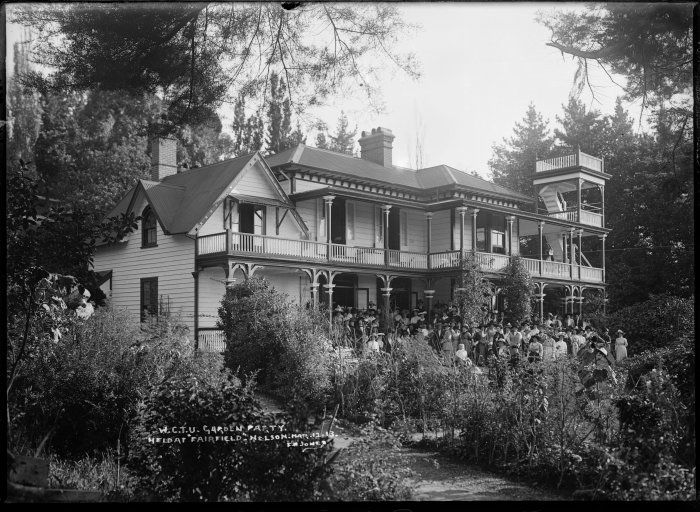Fairfield House
Fairfield House, built by Arthur Atkinson in 1883, was rescued from demolition by a dedicated group of Nelson people
The Changing Faces of Fairfield House
If Fairfield House was a person, it would have a fantastic story to tell. It's the sort of story that would be told sitting around a campfire, marshmallows in hand and mouths open in amazement. It's hard to believe that there is a house in Nelson with so much history.
English lawyer turned emigrant, Arthur Atkinson started the story when he bought an eight acre block of land in 1872 and built the house, in two stages. It was completed in 1883.1 Atkinson also planted many trees in the seven acre woodland around the house, and these remain as heritage listed trees today.
Atkinson's family lived in Fairfield House for around forty years, until 1922, when the house was given to the newly founded Girls' College, which was desperately in need of a boarding hostel.
Fairfield House became an integral part of Girls' College, with many girls living and learning there, as the House also became the first site for a Preparatory school. A dormitory block, for the college girls, consisting of open air cubicles was built on the terrace above Fairfield house in 1926 and housed 24 girls and their Matron for the first four years. Nelson College also had an interest in the House, and moved their boarding students into it after the Murchison earthquake, July 1929, damaged their original hostel. It was used by the Fell House boarders until 1964 when they moved to a new hostel at the school, after a fire ravaged the accommodation block of Fairfield House. The colleges built new hostels closer to their campuses, and all the students had moved out by 1976, after which Fairfield House fell into disrepair.2
In 1979 the College gave Fairfield House to Nelson City Council in exchange for funding for a new sanatorium. It was in this year that a demolition order for the House was about to be put through the Council, and people began to worry about the fate of the beautiful old house that was so close to being destroyed. Out of this came the ‘Friends Of Old Fairfield'3, a group determined to restore the house to its original splendour.
However, the task was to be an almost impossible one. Restoration costs were set to be around $500,000,4 and even with the Friends Of Old Fairfield raising $44,000, it was going to be a long journey. However, the group were committed. A man called Alan Stanton stepped in, quite literally, and saved Fairfield House from being demolished. Stanton "...squatted in near derelict premises..."5 and started restoring the house tirelessly.
Restoration was hindered greatly by thefts. When the house was deserted, collectors came in and took all the original Victorian features, such as lights, switches, and other valuable accessories. Some of the only remaining original features are the front doors, which stand strong despite having over 100 years of weather thrown at them.6
The restoration of Fairfield house took a long time, with many people believing that it would never be completed. Money and time were not the only crucial ingredients to success - it was the dedication and love of the Friends of Old Fairfield that allowed the project to be completed successfully.
Fairfield House is now a Category One Historic Places Trust listed house.
Caitlin Chapman, Nelson College for Girls, 2009
More on Fairfield House and the Atkinsons
Arthur (Samuel) Atkinson was a very talented individual. He was a prominent lawyer and keen astronomer, asked by the Royal Society of London to be an official observer of the Transit of Venus in September 1882. A replica tower replaces the original at Fairfield House, where Arthur's five inch reflector telescope was once mounted. The telescope itself was later moved to Alton Street. Arthur was also a linguist, studying Māori in particular, as well as other Polynesian and Melanesian languages, and an arachnologist. This latter earned him the nickname "spider" Atkinson.
Arthur's wife, (Jane) Maria Atkinson, was active in the suffragette movement and promoted education for girls.
Arthur died in 1902 and Maria in 1914, both are buried at Wakapuaka cemetry.
Nelson City Council, 2011
Updated: April 2020
Story by: Caitlin Chapman
Sources
- Fecit, C.V.(1990) Fairfield House. In Nelson: A City Of History. Nelson, NZ: Nelson City Council
- Top of the South Shopping Guide 25/07/83
- Fairfield House history: the land, the people the house: http://www.fairfieldnelson.org.nz/history#overview
- Government money has poured in to save Fairfield House (1984, June 28) Nelson Evening Mail, p.1
- Government money has poured in to save Fairfield House
- Interview with Catherine Brosnahan 19/05/09
Further Sources
Books
- Lash, M. (1992) Nelson Notables. Nelson, NZ : Nelson Historical Society, pp.11-13
http://www.worldcat.org/oclc/29497366 - Price, K. ( 2008) The school on the Hill: Nelson College for Girls 1883-2007. [Nelson, N.Z. : Nelson College for Girls, 2008]
http://www.worldcat.org/oclc/213329438 - Scholefield, .G. (1960) Richmond-Atkinson papers. Wellington, N.Z. : Government Printer
http://www.worldcat.org/oclc/154274818 - Vine, C. (1992) Nelson observed. Nelson, N.Z. : Nelson Institute
http://www.worldcat.org/oclc/39716974
Newspapers
- Arthur Atkinson: observer of the stars (1996, August 3) Nelson Mail.
- Arthur Atkinson: a thirst for knowledge (1996, July 6) Nelson Mail, p.12
- Farley, S. (1998) Fairfield House completed. New Zealand Historic Places 70, pp. 23-24
- Government money has poured in to save Fairfield House (1984, June 28) Nelson Evening Mail, p.1
- Life and loves of Fairfield House (2005, September) Mudcakes and Roses
- Truman, G. (2011) Five years at Fairfield. Nelson Historical Society Journal, 7(3), p.35
http://nzetc.victoria.ac.nz/tm/scholarly/tei-NHSJ07_03-t1-g1-t5.html - Vine, C. (1991) Historic Fairfield saved. New Zealand Historic Places 35, pp. 26-28
Websites
- Fairfield House : the heart of Nelson. Retrieved 12 January 2010
http://www.fairfieldnelson.org.nz/ - Fairfield House history: the land, the people the house. Retrieved 12 January 2010
http://www.fairfieldnelson.org.nz/history#overview - New Zealand Historic Places Trust : Fairfield House:
http://www.heritage.org.nz/the-list/details/256 - Notable women walk: Alice Mabel Atkinson. Retrieved from Nelson City Council
http://www.nelsoncitycouncil.co.nz/atkinson-alice/

 Fairfield House, 2009
Fairfield House, 2009 The house Fairfield, in Nelson, 12 Mar 1913, F.N.Jones. Alexander Turnbull Library, 1/2-032979-G
The house Fairfield, in Nelson, 12 Mar 1913, F.N.Jones. Alexander Turnbull Library, 1/2-032979-G